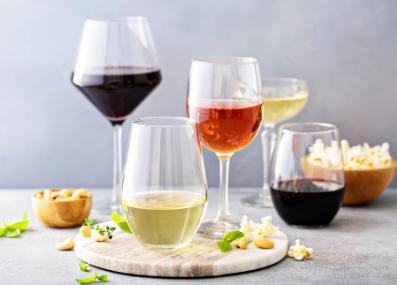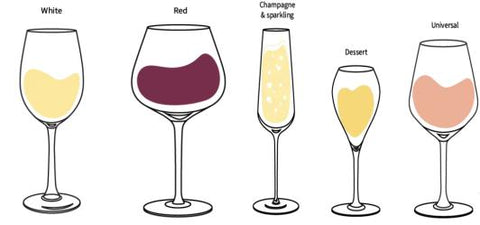Demystifying Various Types of Wine Glasses: Your Essential Guide
Every time you raise a glass of wine for cheers, ever hoped for a better wine glass for a more enjoyable wine-tasting journey? Join here for the world of types of wine glasses, where form meets function to elevate your sipping experience. From the subtle curves that accentuate aromas to the elegant stems that keep your pour at its prime, understanding the art of glassware can truly enhance your wine appreciation.
In this exploration, we'll uncover the anatomy of wine glasses, explore the diverse types tailored for specific varietals, and even decode the science behind choosing the perfect glass to complement your favorite wine. So, let's embark on this enlightening voyage through the lens of wine glass mastery.

What Is a Wine Glass Composed of?
A wine glass comprises four essential components that influence the wine-tasting experience:
- Base: The flat, circular piece at the bottom of the glass, providing stability and ensuring it stands firm on surfaces.
- Stem: The thin, elongated piece between the base and the bowl allows for a comfortable hold without affecting the wine's temperature. It also prevents fingerprints from smudging the bowl.
- Bowl: This is the heart of the wine glass, where the wine is poured and its flavors and aromas are experienced. The size of the bowl varies depending on the wine type – larger for swirling and narrower at the top to capture enticing aromas.
- Rim: The uppermost part of the glass that directs the wine into your mouth. A thinner, smoother rim enhances the sipping experience, while thicker, round rims are commonly found in lower-quality glasses.
Different Types of Wine Glasses

After we know the general construction of common wine glasses, let's explore the common types of wine glasses and their uses with the beginner types of wine glasses chart here.
White Wine Glasses
In the realm of white wine glass uses, elegance meets functionality. A slender, tulip-shaped profile graces these glasses, with a narrow stem and a round bowl that gracefully tapers at its zenith. Why the taper? It ensures your chilled whites remain cool, preserving their crispness. Less aeration is required for whites, and the smaller bowl minimizes swirling, allowing the delicate aromas to converge at the rim, where they tantalize both your olfactory and gustatory senses.
Red Wine Glasses
Bold, commanding, and tailored for the art of swirling, red wine glasses flaunt a larger stature, a robust base, and a wide bowl that ascends to the rim. This design is the orchestra conductor for your reds, orchestrating a dance of oxygenation that unlocks complex aromas and bestows a velvet smoothness upon the tannins. Among several types of red wine glasses, the Burgundy glass, reminiscent of an artist’s palette, and the Bordeaux glass, stately and resplendent, steal the spotlight. Don’t hesitate to swirl with finesse, especially in the Burgundy glass – it’s a symphony of aromas in the making.
Wine Glasses for Sparkling Drinks
Enter the world of celebration, where slender rims define the essence of champagne and sparkling wine glasses. These vessels embrace effervescence, preserving the delicate bubbles and ensuring your bubbly delight remains chilled. The iconic champagne flute, a timeless classic, epitomizes festivity, whether it’s a joyful New Year’s Eve or a heartwarming wedding toast. While the white wine glass might suffice, the flute adds that touch of elegance that transforms an occasion into a memory.
Dessert Wine Glasses
After the final course, when dessert beckons, it's time to embrace the petite charm of dessert wine glasses. These diminutive wonders, in various types of wine glasses shapes, share a common trait – a small bowl that cradles concentrated flavors. Sip by sip, they unfold the rich tapestry of sweetness in dessert wines, elevating your post-meal indulgence. Who needs chocolate lava cake when the dessert wine itself is an exquisite finale?
All-purpose Wine Glasses
For the pragmatist in you, universal wine glasses are the answer. Bridging white and red wine glass uses and features, they boast medium-sized bowls and tapered rims. This versatile glassware adapts seamlessly to diverse varietals, making it your steadfast companion for new vintages and relaxed gatherings. Its unassuming presence lets the wine take center stage while ensuring a satisfying sensory experience.
How to Pick the Wine Glass for You?
Selecting the right wine glass is like finding the perfect frame for a masterpiece. Please consider these factors when choosing your perfect type of wine glasses.
Bowl Shape
The bowl shape can significantly influence your wine experience. A smaller bowl retains delicate white wine aromas, offering a concentrated sensory journey. Conversely, red wines with bolder aromas benefit from wider bowls that enhance aeration, allowing flavors to flourish. Champagne flutes can also preserve effervescence.
Rim Thickness
A finely cut, thin rim facilitates the seamless flow of wine, elevating your taste perception to new heights. The delicate balance of flavors unfolds effortlessly. However, be mindful that thinner rims can be delicate, potentially impacting the glass's long-term durability.
Stemmed vs. Stemless
Stems play a functional role, particularly for white wines like Sauvignon Blanc or Chardonnay. By gripping the stem, you prevent the transfer of heat from your hand, maintaining the wine's ideal chilled temperature. In contrast, stemless glasses offer stability and practicality, making them a versatile option for both casual and formal settings.
Versatility
If you seek versatility, turn to the universal wine glass. With a balanced design, it suits a variety of wines, making it an excellent all-rounder.

What Is the Standard Wine Pour?
Generally, a standard pour typically measures around five ounces, equating to five glasses from a 750ml bottle. However, dessert wines and wine-tasting samples usually come in smaller two-ounce pours due to their sweetness and higher alcohol content.
Moreover, you can also consider the size of the glass for a pour. Larger glasses may warrant a slightly larger pour, while smaller glasses may appear generously filled. Striking the right balance ensures you savor the flavors without overwhelming your senses.
Conclusion
Now you know the different types of wine glasses and the artistry behind wine glass selection. Based on the types of wine glasses chart, each glass is a canvas for flavor. Whether it's the delicate curvature of white wine glasses, the bold design of red wine vessels, or the universal adaptability, our journey through the world of wine glasses reminds us that every sip is a masterpiece waiting to be savored. Cheers to unlocking the full potential of your wine experience!
